Task dependencies are an essential aspect of project management. They help in ensuring that tasks are completed in a specific order, and in a timely and efficient manner.
Dependency is a relationship that exists between tasks, where the completion of one task reflects on another. Understanding the connections between task dependencies within a project is crucial for its successful completion. It helps team members understand the processes in place and collaborate more effectively to meet the set expectations.
Determining task dependencies within a project helps with scheduling, resource allocation, risk management, and sequencing business processes and workflows. By understanding the different types of task dependencies, project managers can ensure that all work required remains on track, that resources are optimally allocated, and that the project is completed on time, and successfully.
In this article, we will clarify what task dependencies in project management are and why they matter. Also, we will outline the 4 main types, and 5 methods to apply them successfully in your business.
Task Dependencies in Project Management: Definition

Task dependencies form the basis of project management. They define the relationships that exist between different project activities and outline the order in which tasks must be done to ensure the project’s success.
Besides the fact that with clear task dependencies, project managers have better visibility on the scope of the tasks at hand, they also help identify risks that may arise in the project.Task dependencies also increase accountability among team members.
Each task has its dependencies to other tasks, and if one of them is late, it can delay the entire project. Therefore, each employee is responsible for the timely completion of their ‘part’, ensuring that the project remains on track.
4 Types of Task Dependencies

The four main types of task dependencies are mandatory, discretionary, external, and internal.
Mandatory (Sequential) Dependencies: Mandatory dependencies occur when one task cannot start until another is completed. This type is crucial to the successful completion of a project as it outlines the sequence, or order, tasks must follow to ensure achievement of all objectives.
Discretionary (Preferential) Dependencies: Discretionary dependencies refer to tasks that could happen at the same time, but may benefit from completing them in a particular order. These types of task relationships can help with task sequencing to ensure that end outcomes happen faster and more efficiently.
External Dependencies: External dependencies refer to tasks that require outside resources to complete. These could be third-party vendors, other departments within the company, or the customer themselves. Project managers need to understand these external dependencies and ensure they are have the preparation necessary when it comes time to carry out the task.
Internal Dependencies: Internal dependencies refer to tasks that are dependent on resources within the organization, such as the availability of team members or specific hardware. They allow better resource allocation and prompt task completion.
Task Dependency Management: 5 Main Methods

Precedence Diagramming Method (PDM)
PDM is a network diagramming technique that models activity sequences in a project. It is an effective tool for task dependency management because it shows the exact relationships between different activities. PDM can identify the start and finish dates of different activities and an entire project.
Critical Path Method (CPM)
The critical path method is another effective tool for task dependency management. It helps identify the most critical activities in a project that must happen on time to meet the project’s deadline. The critical path method provides project managers with a clear understanding of how different tasks interact with each other and what activities are essential to the successful completion of the project.
Gantt Charts
Gantt charts are perhaps the most popular method for task dependency management. They are simple to understand and allow project managers to visualize all the stages of a project, the amount of time to complete each task, and the dependencies between them. Gantt charts can help you analyze task time frames, identify critical paths, and ensure dependencies are appropriately scheduled.
Resource Dependency Method
The resource dependency method uses a combination of scientific principles to determine the amount of time and resources to complete a task, and the task dependencies. It can help optimise resource allocation and ensure that successful completion of tasks within the time frame.
Agile Methodology
Agile methodology is a project management approach that involves breaking the project down into smaller, manageable chunks (“sprints’). Each sprint is a set period where your team needs to complete a specific group of tasks. Agile methodology can be effective for task dependency management because it encourages flexibility and adaptability.
Tasks assignment depends on priority. Thus, the completion of one task becomes a dependency for the next. This approach ensures that your team prioritises critical tasks completes on time, while still allowing for changes and modifications to the project plan as needed.
Bottom Line
Task dependencies are hugely important for the successful completion of projects. Having a thorough knowledge and understanding of the different types helps to proactively work on projects, create an efficient workflow, foresee potential problems and ultimately complete work faster. With the help of various methods such as PDM, CPM, Gantt Charts etc., project managers can efficiently manage task dependencies and ensure that projects run smoothly.
If you’re looking to streamline complex business processes within your project better, SaaS BPM may just be the solution you need! With our simple yet powerful software, you can easily visualize complex process flows with dynamically changing data, making collaboration much more efficient across teams. Achieve success in all your project management tasks today – try SaaS BPM now!

